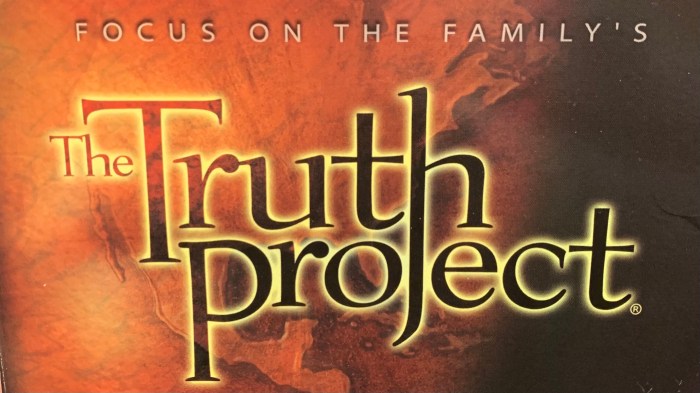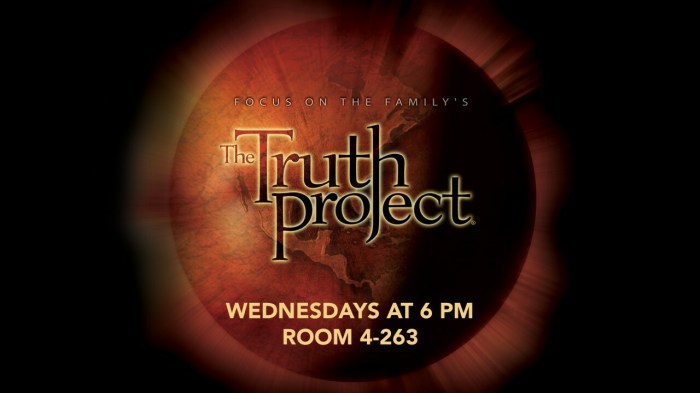The Truth Project Lesson 1 invites us on an intriguing journey to explore the multifaceted concept of truth. From its elusive nature to its profound impact on our lives, this lesson promises to challenge our assumptions and deepen our understanding of the world around us.
We will delve into the various definitions and perspectives on truth, unraveling the distinction between objective and subjective realities. The role of evidence and reason in determining truth will be examined, along with the influence of perception and interpretation on our understanding of reality.
Overview of The Truth Project Lesson 1

The Truth Project Lesson 1 provides an introduction to the fundamental principles of Christianity, exploring the existence of God, the nature of humanity, and the purpose of life.
The lesson aims to establish a solid foundation for understanding the Christian faith, equipping participants with essential knowledge and insights into the core beliefs and teachings of Christianity.
Key Concepts
- The existence of God and the evidence supporting it.
- The nature of humanity, including our inherent sinfulness and need for redemption.
- The purpose of life, as revealed through God’s plan for humanity.
- The significance of Jesus Christ and his role in salvation.
Essential Points
- God is a loving and personal creator who desires a relationship with humanity.
- Humanity is fundamentally flawed and in need of God’s grace and forgiveness.
- The purpose of life is to know God, glorify him, and enjoy him forever.
- Jesus Christ is the only way to salvation and eternal life.
Exploring the Concept of Truth

Truth is a fundamental concept that has been explored by philosophers, scientists, and theologians for centuries. In everyday language, truth is often understood as the correspondence between a statement and reality. However, there are different definitions and perspectives on truth that have been developed over time.
Definitions and Perspectives on Truth
- Correspondence Theory:Truth is the correspondence between a statement and reality. For example, the statement “The sky is blue” is true because the sky actually is blue.
- Coherence Theory:Truth is the coherence of a statement with a set of other statements that are already believed to be true. For example, the statement “The earth is round” is true because it is consistent with a large body of other scientific knowledge.
- Pragmatic Theory:Truth is whatever works in practice. For example, the statement “The sun rises in the east” is true because it is a useful way to predict the daily cycle of light and darkness.
Objective vs. Subjective Truth
One of the key distinctions in the philosophy of truth is the distinction between objective and subjective truth. Objective truthis truth that is independent of the individual’s beliefs or experiences. For example, the statement “The speed of light is 299,792,458 meters per second” is an objective truth that is true regardless of what any individual believes.
Subjective truth, on the other hand, is truth that is dependent on the individual’s beliefs or experiences. For example, the statement “I like chocolate” is a subjective truth that is true for me, but it may not be true for someone else who does not like chocolate.
The Role of Evidence and Reason in Determining Truth, The truth project lesson 1
In order to determine whether a statement is true, it is important to consider the evidence and reason that support it. Evidenceis anything that can be used to support a statement, such as facts, data, or testimony. Reasonis the process of using evidence to reach a conclusion.
By carefully considering the evidence and reason that support a statement, we can increase our confidence in its truthfulness.
The Nature of Reality

Reality is a complex and multifaceted concept that has been pondered by philosophers, scientists, and theologians for centuries. It is often defined as the sum of all that exists, but this definition raises questions about what exists and how we know it.
There are many different theories and models of reality, each with its own strengths and weaknesses. Some of the most common theories include:
- Objective reality: This theory holds that reality is independent of our perceptions and interpretations. It exists objectively, regardless of whether or not we are aware of it.
- Subjective reality: This theory holds that reality is created by our minds. It is a product of our perceptions, experiences, and beliefs.
- Interdependent reality: This theory holds that reality is both objective and subjective. It is shaped by both our perceptions and the external world.
The nature of reality has a profound impact on our understanding of truth. If reality is objective, then truth is absolute and unchanging. If reality is subjective, then truth is relative and personal. If reality is interdependent, then truth is a complex and ever-evolving process.
Perception and Interpretation
Our perception and interpretation of reality play a significant role in shaping our understanding of truth. We all experience the world through our own unique filters, which are influenced by our culture, our experiences, and our beliefs. This means that we can never fully understand reality as it is, but only as we perceive it.
The Truth Project Lesson 1 highlights the importance of critical thinking and evaluating information. This lesson serves as a foundation for understanding the SWOT analysis of Toms Shoes, which involves examining the company’s strengths, weaknesses, opportunities, and threats. By applying the principles of The Truth Project Lesson 1, we can effectively assess Toms Shoes’ competitive position and make informed decisions about its future.
Perception and interpretation are not always accurate or reliable. We can be fooled by our senses, and we can be biased by our expectations. This can lead us to believe things that are not true, or to miss things that are important.
It is important to be aware of the role that perception and interpretation play in our understanding of truth. We should be critical of our own beliefs and open to new ideas. We should also be willing to listen to the perspectives of others, even if they differ from our own.
The Search for Truth: The Truth Project Lesson 1
The pursuit of truth is a fundamental human endeavor. Throughout history, philosophers, scientists, and scholars have sought to uncover the nature of reality and to understand the world around us. The search for truth involves various methods and approaches, each with its strengths and limitations.
Methods of Finding Truth
There are numerous methods used in the pursuit of truth. Some of the most common include:
- Reason and Logic:Using deductive and inductive reasoning to derive conclusions from premises.
- Empirical Observation:Gathering data through observation and experimentation to test hypotheses and theories.
- Testimony and Tradition:Relying on the accounts of others or on established beliefs and practices.
li> Intuition and Inspiration:Trusting in one’s own inner insights and creative impulses.
Critical Thinking and Intellectual Humility
In the search for truth, critical thinking and intellectual humility are essential. Critical thinking involves examining evidence, identifying biases, and evaluating arguments logically. Intellectual humility allows us to recognize the limits of our knowledge and to be open to new ideas and perspectives.
Challenges in the Pursuit of Truth
The pursuit of truth is not without its challenges. Some of the most common obstacles include:
- Cognitive Biases:Unconscious biases that influence our perception and reasoning.
- Emotional Interference:Feelings and emotions can cloud our judgment and hinder our ability to think clearly.
- Limited Information:We often have incomplete or inaccurate information, which can lead to false conclusions.
- Deception and Propaganda:False or misleading information can intentionally deceive us and hinder our search for truth.
The Importance of Truth

Truth, the cornerstone of a meaningful and ethical existence, holds immense significance in every facet of our lives. It shapes our decisions, relationships, and the very fabric of society. Embracing truth is not merely an intellectual pursuit but a moral imperative, as it fosters trust, promotes justice, and ensures the well-being of individuals and communities.
Ethical Implications
Truth is the bedrock of ethics and morality. It provides a compass for right and wrong, guiding our actions and shaping our character. By adhering to truth, we demonstrate integrity, honesty, and a commitment to justice. Conversely, denying or distorting truth erodes trust, undermines accountability, and creates a culture of deceit and corruption.
Social Implications
Truth is essential for the smooth functioning of society. It fosters cooperation, builds bridges between communities, and promotes a shared understanding of reality. When people share a common commitment to truth, they can engage in meaningful dialogue, resolve conflicts peacefully, and work together towards common goals.
In contrast, the absence of truth leads to mistrust, division, and social unrest.
Personal Implications
Truth is crucial for our personal well-being and growth. It allows us to live in alignment with our values, make informed decisions, and build meaningful relationships. By embracing truth, we gain self-awareness, develop a sense of purpose, and experience a deep sense of fulfillment.
Conversely, living a lie or denying the truth can lead to cognitive dissonance, anxiety, and a loss of self-esteem.
Truth in the Digital Age
In the era of the internet and social media, our perception of truth has undergone a profound transformation. The vast flow of information available online presents both opportunities and challenges in our quest for truth.
One of the key impacts of technology on our perception of truth is the ease with which information can be disseminated and shared. Social media platforms have become powerful tools for communication, allowing individuals to share their perspectives and connect with others who share their views.
However, this ease of sharing has also led to the spread of misinformation and disinformation.
Challenges of Navigating Misinformation and Disinformation
Misinformation refers to false or inaccurate information that is unintentionally spread, while disinformation is false or inaccurate information that is intentionally spread to deceive or mislead. Both misinformation and disinformation can have a detrimental impact on our ability to discern truth, as they can blur the lines between fact and fiction.
The spread of misinformation and disinformation online is facilitated by several factors, including:
- The echo chamber effect, where individuals are exposed to information that confirms their existing beliefs, reinforcing those beliefs and making them less likely to consider alternative perspectives.
- Confirmation bias, where individuals tend to seek out information that supports their existing beliefs and discount information that contradicts them.
li>The anonymity of online communication, which can make it easier for individuals to spread false information without fear of consequences.
Strategies for Verifying and Evaluating Information Online
In light of the challenges posed by misinformation and disinformation, it is essential to develop strategies for verifying and evaluating information online. These strategies include:
- Checking the source of information: Consider the credibility and reliability of the website or organization providing the information.
- Fact-checking: Use reputable fact-checking websites to verify the accuracy of information.
- Lateral reading: Read articles from a variety of sources to get a balanced perspective and identify any biases or inconsistencies.
- Being aware of your own biases: Recognize your own biases and be open to considering alternative viewpoints.
Answers to Common Questions
What is the purpose of The Truth Project Lesson 1?
To provide a comprehensive overview of the concept of truth, exploring its nature, significance, and the challenges of finding it.
How does The Truth Project Lesson 1 define truth?
It explores various definitions and perspectives on truth, highlighting the distinction between objective and subjective realities.
What is the role of evidence and reason in determining truth?
Evidence and reason play crucial roles in evaluating claims and determining their truthfulness.
How does perception and interpretation influence our understanding of truth?
Perception and interpretation can shape our subjective experiences and beliefs, potentially influencing our understanding of truth.